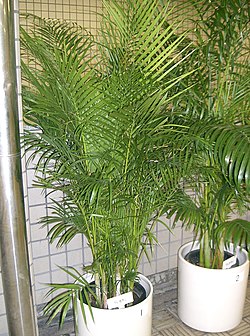Dypsis lutescens
| Habit | palm-cycad
| |
|---|---|---|
| Height: | ⇕ | 6 m"m" can not be assigned to a declared number type with value 6. to 12 m"m" can not be assigned to a declared number type with value 12. |
| Lifespan: | ⌛ | perennial |
| Features: | ✓ | foliage |
|---|
If this plant info box on watering; zones; height; etc. is mostly empty you can click on the edit tab and fill in the blanks!
Dypsis lutescens (Golden Cane Palm, Areca Palm, or Butterfly Palm) is a species of palm, native to Madagascar.
It is a small to medium-sized palm, growing to 6-12 m tall, with multiple stems from the base. The leaves are arched, 2-3 m long, and pinnate, with 40-60 pairs of leaflets. It produces offsets, and these can be cut off when mature enough as a propagation method.
It is grown as an ornamental plant in gardens in tropical and subtropical regions, and elsewhere indoors.
Areca palm trees are commonly referred to as the Butterfly palm, and has many other common names. But, the butterfly palm is the most descriptive as to the areca's aesthetics. The leaves curve upwards in multiple stems to create a butterfly look. They are sometimes used as privacy wall or fence. The areca palm is sometimes confused with many other plants in the genus, because of the palm family name,"areca." The areca palm, above all other indoor palm trees, is most commonly found in households.[1]
In its introduced range, this plant acts as a supplier of fruit to some bird species who feed on it opportunistically, such as the Pitangus sulphuratus, Coereba flaveola and Thraupis sayaca species in Brazil.[2]
Read about Dypsis lutescens in the Standard Cyclopedia of Horticulture
|
|---|
|
Chrysalidocarpus lutescens, Wendl. (Hyophorbe indica, Gaertn. H. Commersoniana, Mart. Areca lutescens. Bory). St. 30 ft. high, 4-6 in. diam., cylindrical, smooth, thickened at the case: lvs. very long; segms. almost opposite, lanceolate, 2 ft. long, 2½ in. wide, acute, with 3 prominent primary nerves, which are convex below and acutely 2-faced above. Bourbon.— In growing Chrysalidocarpus (or Areca) lutescens in quantity, it will be found a good plan to sow the seeds either on a bench, in boxes or seed-pans, so prepared that the seedlings will remain in the soil in which they germinate until they have made 2 or more lvs. The first lf. made above the soil is small, and if plants are potted off at this stage they must be very carefully watered in order not to sour the soil. In the preparation of the receptacles for the seed, a little gravel in the bottom will be found good, as the roots work very freely through it, and when the time comes to separate the plants previous to potting, it is an easy matter to disentangle the roots without bruising them. Probably the plan which works best is to wash the soil and gravel entirely from among the roots. Pot in soil not too dry, and for the next few days keep the house extra warm and humid, and the plants shaded from the sun without any moisture applied to the soil. CH
|
Cultivation
- Do you have cultivation info on this plant? Edit this section!
Propagation
- Do you have propagation info on this plant? Edit this section!
Pests and diseases
- Do you have pest and disease info on this plant? Edit this section!
Species
Gallery
If you have a photo of this plant, please upload it! Plus, there may be other photos available for you to add.
References
- Standard Cyclopedia of Horticulture, by L. H. Bailey, MacMillan Co., 1963
External links
- w:Dypsis lutescens. Some of the material on this page may be from Wikipedia, under the Creative Commons license.
- Dypsis lutescens QR Code (Size 50, 100, 200, 500)
- ↑ "Real Palm Trees". Palm Tree General Description.
- ↑ Leonardo Barros Ribeiro & Melisa Gogliath Silva. "Comportamento alimentar das aves Pitangus sulphuratus, Coereba flaveola e Thraupis sayaca em palmeiras frutificadas em área urbana". Template:Pt icon
